Car Hire: Everything You Need To Know About Renting a Car On Vacation For The Ultimate Road Trip
How To Choose The Right Hire Car, Save Money, Avoid Expensive Mistakes And Have The Road Trip Of Your Life!

If you’re considering renting a car and are confused by all the options, insurances, excess, terms, conditions and restrictions, this is the guide for you…
We’ve created a one-stop shop for everything you need to know about renting a car whether it’s for business, pleasure or a good old-fashioned road trip.
With a little info, renting a car is as easy and as hassle-free as cruising down the Pacific highway in a convertible with nothing but the open road in front of you.
Let’s get into it…
Vehicles Types: How To Choose The Best Rental Vehicle For Your Trip
Match the vehicle to the type of trip you’re doing
Which kind of vehicle are you’re going to hire?
The romance of hiring a red convertible is a nice thought, until you remember it’s a family road trip with your three kids!
Thinking practically is a good rule of thumb for all thing’s car rental.

Tip:
“Sometimes an upgrade is not an upgrade. When they want to upgrade you from the compact car you rented to the SUV, it isn’t because they are being nice.
It could be because no one else wanted to try and find a place to park such a big vehicle in on-street parking. It’s great to have a bigger car for a long road trip with friends, sure, but bigger is not always better. “
Chris Christiansen – AmateurTraveler.com
Comfort Requirements
Seeing as most rental cars are new and serviced regularly we can skip on choosing a car for its reviews on reliability, so the first consideration is comfort.
Think about the length of your trip, the terrain, the environment.
You can rent 4x4s, SUV’s, hatchbacks, hybrids, sedans and convertibles on a range of budgets, so weigh it all up first.
Comfort tips to consider when renting a vehicle:
- A 4WD will have you sitting higher which means you can see above traffic and see sights and street names (!) easier.
- An automatic gearbox can make for easier driving, especially for longer drives or when you’re busy looking out for streets to turn into.
- Convertibles are great for coastal or country driving (but close the top for highway driving!), and not so good for city-driving due to the pollution factor.
- Having a sedan allows you to lock your suitcases out of sight of would-be-thieves in the trunk. Whereas station wagons leave your belongings a bit more exposed.
- Hire a vehicle with cruise control to make longer drives that much easier… ‘set and forget’ your speed and avoid speeding fines too!
Hire Car Security Requirements
It’s in the interest of the rental car company to ensure their vehicles are up to date with the latest security technology, so it’s down to you to make sure all of your belongings are out of view of would-be thieves.
Think about opting for a vehicle that is big enough to ensure those huge suitcases are out of sight, for example, because if the car is broken into or stolen, insurance might cover the cost of replacing your belongings but your holiday is probably over.
Car Security Tips For Your Road Trip:
- Remove or hide valuables from sight (either take them with you or lock them in the glovebox as a minimum)
- Hire a car with tinted windows if possible
- Purchase a steering wheel lock (a great visual deterrent)
- If suitcases are visible, lock the suitcase itself, and use a long cable and padlock to secure the suitcase to an arm rest or similar (if they get in, they still can’t take the suitcases!)
- Remove any car hire brand stickers from the vehicle (they’re often on the rear window) – hire cars are valuable targets for thieves
- Park your vehicle in well-lit areas
- Check twice that the doors are locked before you walk away
Car Rental Size Guide: What’s The Difference?
Car rental companies segment their vehicle sizes in terms of categories.
So, it’s important to think about what you need in the same way.
They also have different makes and models of vehicles, so try not to think too much about the specific car you’d like to hire, think more about the size category of vehicle that will suit your needs.
Car Rental Vehicle Size Categories:
Economy:
- Engine size approximately 1.3 litre (4 cylinder)
- 2/4 doors
- Space for maximum 4-5 adults
- Fuel consumption 7 litres / 100 Kms (34 miles per US gallon / 40 miles per imperial (UK) gallon)
- Luggage capacity for 1 large + 1 small suitcases
- Example vehicles: Toyota Yaris, Ford Fiesta, Fiat 500, Citroen C3, Opel Corsa, Renault Twingo or similar
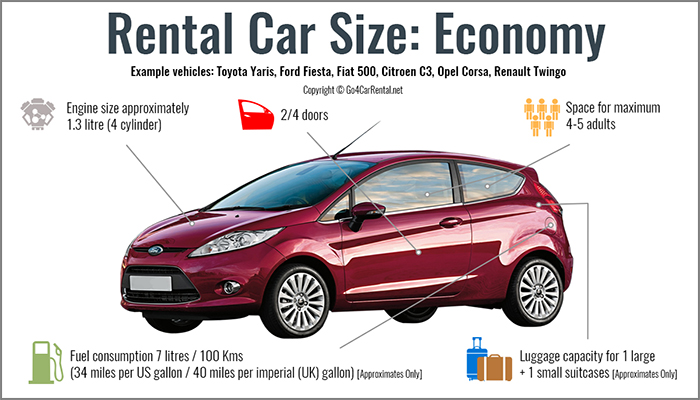
Compact:
- Engine size approximately 1.5 litre (4 cylinder)
- 2/4 doors
- Space for maximum 4-5 adults
- Fuel consumption 7 litres / 100 Km (34 mpg (US) or 40 mpg (UK))
- Luggage capacity for 1 large + 1 small suitcases
- Example vehicles: Kia Rio, Ford Focus, Peugeot 308, Renault Megane, VW Golf, Seat Leon or similar
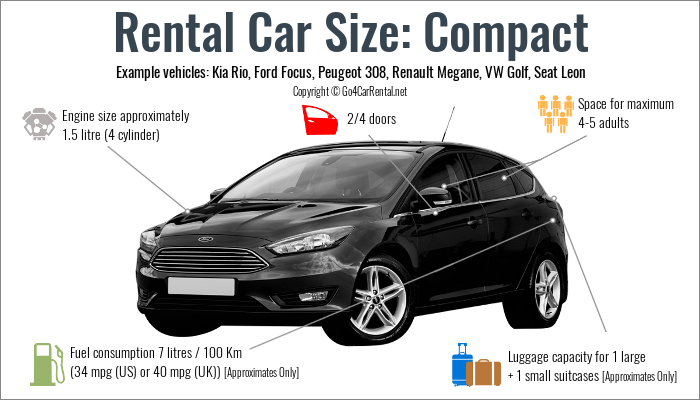
Intermediate:
- Engine size approximately 1.8 – 2 litre (4 cylinder generally)
- 2/4 doors
- Space for maximum 5 adults
- Fuel consumption 8 litres / 100 Km (30 mpg (US) or 36 mpg (UK))
- Luggage capacity for 2 large + 1 small suitcases
- Example vehicles: Toyota Corolla, Hyundai Elantra, Peugeot 508, Ford C-Max or similar

Full Size/Large:
- Engine size approximately 2.5 – 3.5 litre (4-6 cylinder)
- 4 doors
- Space for maximum 5 adults
- Fuel consumption 12 litres / 100 Km (20 mpg (US) or 24 mpg (UK))
- Luggage capacity for 2 large + 2 small suitcases
- Example vehicles: Toyota Camry, Ford Fusion, Subaru Liberty, Ford Falcon, or similar
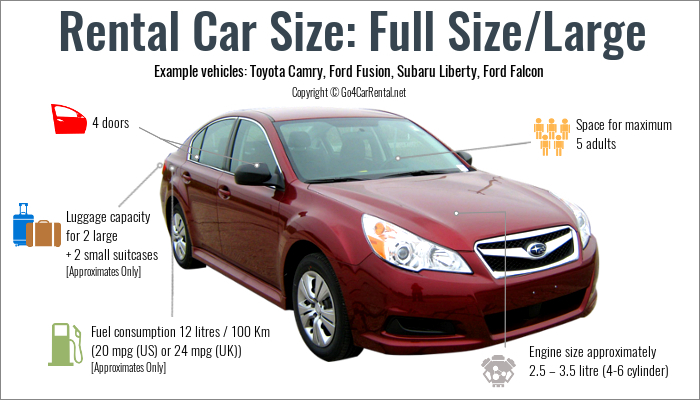
Station Wagon / Estate:
- Engine size approximately 2.5 – 3.5 litre (6 cylinder usually)
- 4 doors
- Space for maximum 5 adults
- Fuel consumption 10 litres / 100 Km (24 mpg (US) or 28 mpg (UK))
- Luggage capacity for 1 large + 1 small to 3 large suitcases
- Example vehicles: VW Passat, Skoda Octavia, Volvo V60, Audi A4, Renault Megane, Peugeot 308 or similar
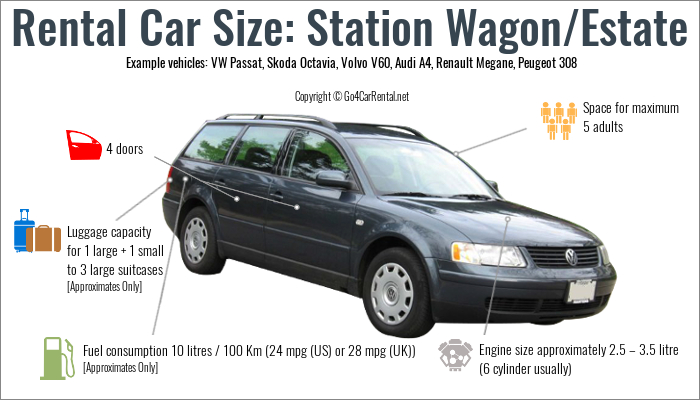
People Carrier / Van:
- Engine size approximately 2.5 – 3.5 litre (6 cylinder usually)
- 4 doors
- Space for maximum 7-12 adults
- Fuel consumption 12 litres / 100 Km (20 mpg (US) or 24 mpg (UK))
- Luggage capacity for 2-3 large suitcases + 1-3 Small suitcases
- Example vehicles: Hyundai iMax, Toyota HiAce, Kia Carnival, Toyota Commuter, Ford Transit, Mercedes Benz GLS, Dodge Grand Caravan, Seat Alhambra or similar
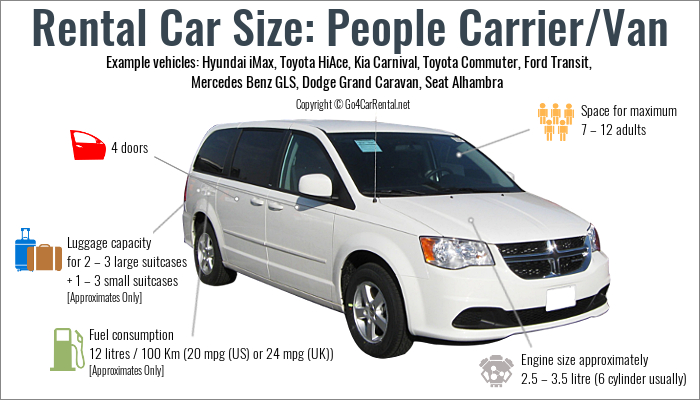
Premium / Luxury:
- Engine size approximately 2 – 3.5 litre (4 or 6 cylinder generally)
- 2/4 doors
- Space for maximum 5 adults
- Fuel consumption 8 litres / 100 Km (30 mpg (US) or 36 mpg (UK))
- Luggage capacity for 1 large + 2 small suitcases
- Example vehicles: Mercedes Benz C300, Mercedes E Class, Chrysler 300, Porsche Panamera, Audi A4, BMW 520 or similar
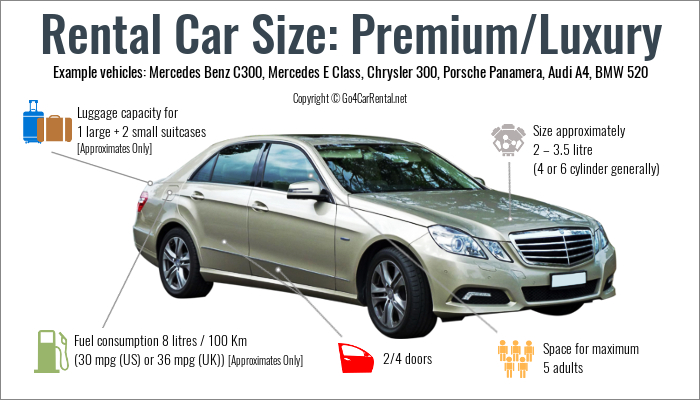
SUV / 4WD:
- For SUV’s the engine size can be from 2.5 litre (4 cylinder) and upwards to 5 litre (6 or 8 cylinder)
- 4 doors
- Space for maximum 5-7 adults
- Fuel consumption 12 litres / 100 Kms (20 mpg (US) or 24 mpg (UK))
- Luggage capacity for 2 large + 1/2 small suitcases
- Example vehicles: Mitsubishi ASX, Toyota Prado, Toyota Rav 4, Nissan Qashqai, Mitsubishi Pajero, Nissan Pathfinder, or similar
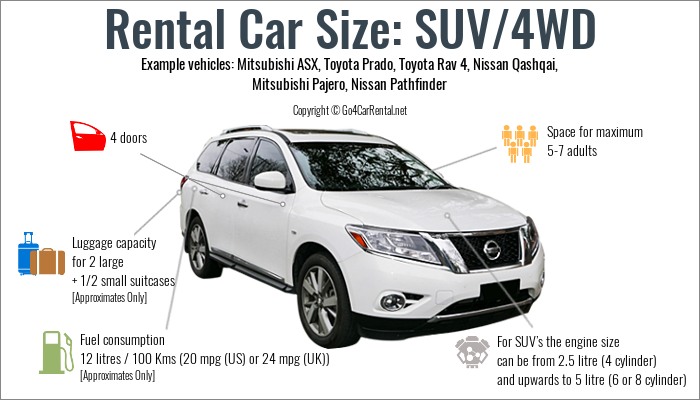
4WD vehicles have limited availability in most counties, and 4×4 vehicles tend to be larger with higher fuel consumption.
Convertible:
- Size approximately 2.5 litre, up to 5L (4-6 cylinder, up to 8 cylinder)
- 2 doors
- Space for 2-4 adults depending on the vehicle
- Fuel consumption anywhere from 10 litres / 100 Km (eg. Mini Cooper S) (24 mpg (US) or 28 mpg (UK)) TO …18 litres / 100 Km (eg. Ford Mustang) (42 mpg (US) or 50 mpg (UK))
- Luggage capacity for 1 large + 1 small suitcases
- Example vehicles: Mini Cooper S, Audi A5, Fiat 500 Cabrio, Ford Mustang, Chevrolet Camaro or similar

Hybrid / Electric:
- Currently there are very limited numbers of Hybrid/Electric rental cars available, and only in certain countries.
- The size and fuel efficiency of these varies considerably depending on the brand of car being used.
- The availability of Hybrid/Electric vehicles is likely to increase quite quickly over the next few years.
- Example vehicles: Toyota Prius, Toyota Camry Hybrid, Hyundai Ioniq, Tesla Model S or similar
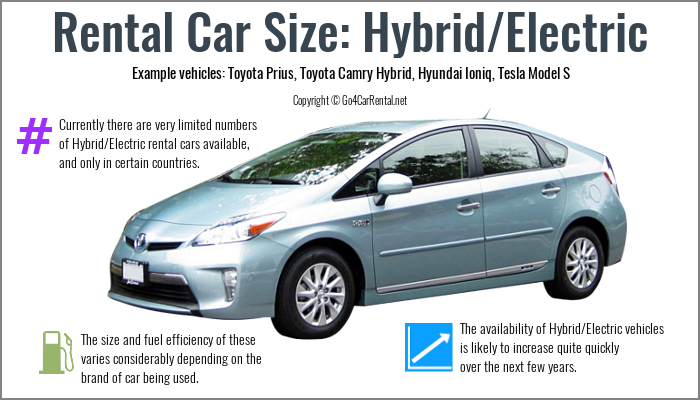
With all the rental vehicle specifications mentioned above regarding size, fuel consumption and luggage capacity, these are only given as a rough guide.
Please check the details given by the car rental company when you search online for the specifications relating to the car hire you are booking.
Pros And Cons Of Various Sizes / Categories Of Rental Vehicles
The category of vehicle you choose will vary firstly on the number of passengers you’ll have, and then onto other variables such as the season, the country, comfort preferences, accessories, make/model, budget and aesthetics.
Here are some pros and cons to consider with each category of vehicle…
Hatches / Hatchbacks:

Pros: Smaller cars are often extremely economical, they’re often easier to drive and park and are cheaper to rent than larger vehicles.
Cons: The smaller the car, the less space.
So, you can only fit a limited number of people and a finite amount of luggage on board.
Sedans:
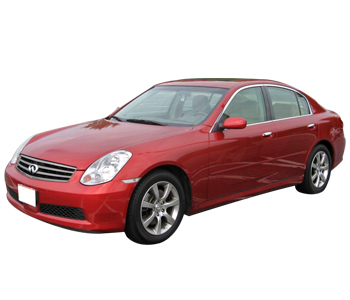
Pros: Larger than hatchbacks, there is more room in the back for passengers and more room for luggage in the trunk.
They are generally pretty economical compared to, say, an SUV or similar.
Cons: A sedan can be tricky to drive if the driver is used to a smaller hatchback size.
You also get less kilometres/miles to the gallon than in a hatch.
Station Wagon / Estate:

Pros: There is huge amounts of space for luggage in a wagon/estate car.
There’s also plenty of extra room for passengers in the back.
Cons: They’re rather long, making parking a bit trickier.
Their length isn’t best suited for urban driving.
They’re also a little sluggish compared to lighter, smaller cars.
4WD / SUV:
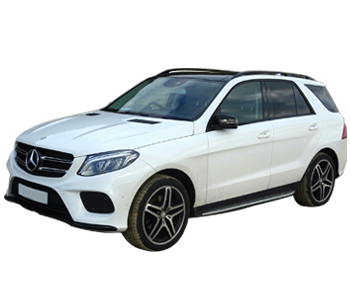
Pros: You can often fit more people in an SUV or 4WD vehicle.
In the larger vehicles, there’s lots of room for suitcases, etc.
They often come equipped with more safety features than other vehicles and are more adept at tackling a variety of terrains.
Cons: They can be quite tricky to drive and are rather thirsty.
People Carrier / Vans:
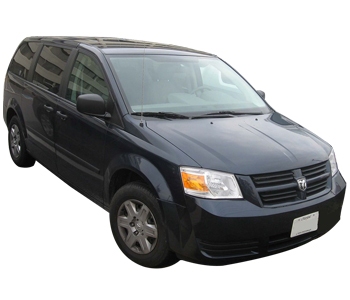
Pros: Put simply – space.
You can fit lots of people and lots of stuff inside a van.
Cons: Kilometres/miles to the gallon so you’ll spend more on fuel than you might in a smaller vehicle.
They’re not the easiest to drive in city centres and parking in tight spaces is off limits.
Convertibles:
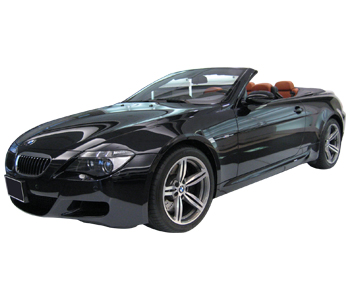
Pros: Dropping the roof and letting the wind through your hair!
Cons: A lack of space, sometimes poor fuel consumption and often more expensive to hire – especially if you opt for a sporty model.
Luxury:
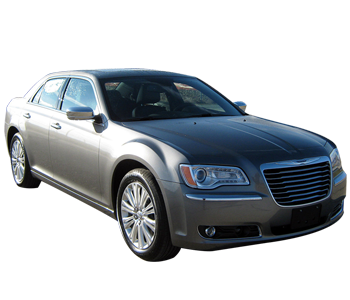
Pros: Paying a little extra for luxury means you get the pick of the features.
You also get space, quality, a great drive and all the other benefits that come with cruising around in a top of the range car.
Cons: Luxury costs money.
So not only will your car rental prove pricey to arrange, you may have to shell out more money on fuel than with a regular sedan.
Documents Required To Hire a Car
To hire a car, the documents you’ll need include a valid driver’s license and a credit card, but terms, conditions and minimum age requirements can vary, so check in advance.
Some companies may ask to see your passport too if you’re not native to the country you’re hiring a vehicle within.
Driver’s License: A full, valid driver’s license in English is required for vehicle rental.
International Drivers Permit: For car rental drivers with licenses in any other language outside of English, you’ll require an International Driver’s Permit or an approved English translation of your license or permit, depending on your destination.
These can be acquired from the transport agency from the country of your destination, the authority that issued your overseas license or from your native country’s high commission, embassy or consulate.
Passport: A valid Passport from your country of origin is required for auto hire for non-native citizens of the country you’re hiring the vehicle in.
Tickets: You may need to provide flight, cruise ship or airline tickets to hire a car as proof that you’ll be returning home at some point. Car hire policies vary so check carefully.

Car Rental Costs: Save Money And Avoid Common Mistakes
This car hire guide has been designed to ensure you know as much as possible about renting a vehicle prior to making your booking.
Always check the terms and conditions, ask direct questions to the employees of your motor vehicle rental company to avoid unexpected costs from arising before, during or after your trip.
Here are common costs of renting a vehicle:
Hire Fee Per Day
The vehicle rental fee charged per day depends on a number of variables that range from the vehicle type to the time of year.
Insurance
Car hire companies will charge you a fee for insurance cover, this amount will be determined by the status of the driver, such as age, but most car rental companies will allow the driver to use their own existing insurance policy (check with your current vehicle insurance company to see if you’re covered).
Driver Under 25
To hire a car in most countries you need to be over 21. Drivers under the age of 25 may have to pay a Young Driver Surcharge, so check the small print if this applies to you.
Additional Drivers Listed
Some motor vehicle rental agencies levy a fee if more than one person will be driving the vehicle, so if you want an additional driver listed you may be able to save money simply by choosing a company who waives additional driver fees.
Costs of Damages
Generally speaking, if your rental vehicle is seriously damaged you will only pay the excess (called a ‘deductible’ in the USA) on the insurance to repair the bodywork, so long as you’re in possession of a Damage Waiver (or a Collision Damage Waiver). Minor damage such as scratches on paintwork or marks on the upholstery will be covered by your holding deposit or bond. Take photos of the vehicle upon pickup to use as proof if you’re later accused of scratches or dents on the vehicle.
Holding Deposit / Bond
This is the fee you’ll be required to pay prior to pickup of your hire car. It’s refundable so long as your rented vehicle is returned in the condition recorded in your agreement at the time of pickup. (Reminder: Take photos!)
Unexpected Costs
This is a simple case of buyer beware. The best car rental advice we can give you is to study the Terms & Conditions in addition to asking direct questions and checking answers to avoid surprises.
Cancellation Fees
Some companies offer ‘free cancellation’ within a specified time-frame as standard, but others may charge you a cancellation fee. It’s worth remembering that ‘free cancellation’, comes with separate T&C’s, so check.
Hidden Fees
The number one car hire tip is to thoroughly check all the details in the small print before you hand over your credit card. Virtually all car rental companies will have costs that you may not have considered, such as charges for accessories (eg. GPS unit, baby seat, etc).
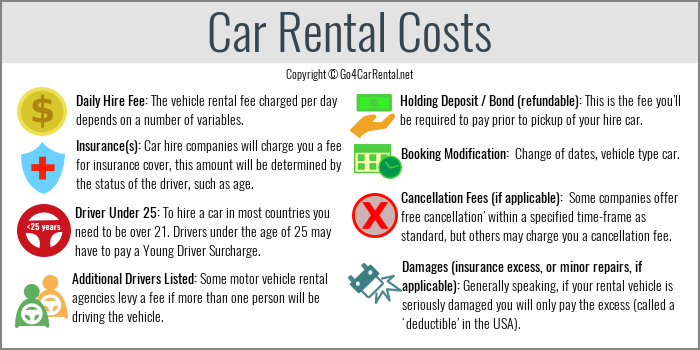
Tips To Save Money On Car Hire
There are a number of things to know about rental cars and practical measures you can take to ensure you spend less on car hire and have more money to spend on enjoying your trip.
- Book early: You’ll got a much better chance of getting the deal you want or expect to get by booking as far out from your travel dates as possible.
- Be clockwise: You may be charged an extra day if your auto rental isn’t returned on or before a designated time.
- Be practical: Remember, you pay for the fuel, so a family of four is going to be better off with a thrifty sedan than a gas guzzling SUV.
- Be driver aware: If the driver is under 25, they may be liable to pay a Young Driver Surcharge.
- Accessorise: Car rental companies usually charge extra for child seats and GPS systems, for example.
- Insure against fees: There are plenty of insurance companies that offer policies that cover the hire car driver against any additional, unexpected fees by the car rental company. In the unlikely event of an accident, this may save you a fortune.
- Be fuel-wise: Most commonly you’ll be required to return your auto rental with a full tank of fuel, commonly known as ‘full to full‘. Be more cautious of ‘full to empty’ when you can return a vehicle rental with little or no fuel because you may get charged hidden ‘service’ fees or be charged an exorbitant rate per gallon/litre for them to fill up the tank after you hand in your vehicle.
- Best Practice: Photograph all the dings and scratches inside and outside the vehicle and ensure the car rental company have a written, recorded note of all the pre-existing damage before you drive your rental vehicle away. This increases the chances of getting back your deposit back should there be any discrepancies regarding damage liability.
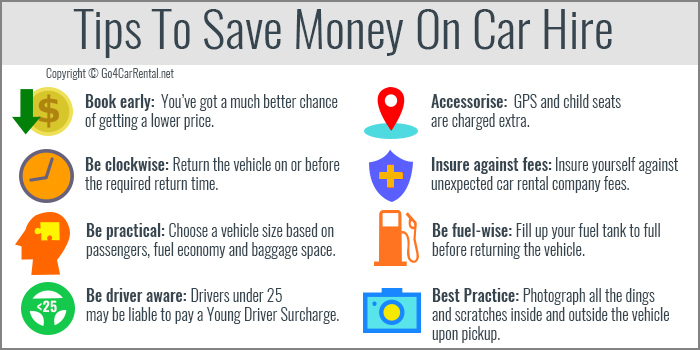
Paying For a Hire Car By Credit Card
Commonly, when you hire a car with a credit card, you’ll pay the agreed car hire fee for the number of days you booked for, either before or on the day when you pick up the vehicle.
And your deposit/bond is simply blocked-out/held on your credit card, then released when the vehicle is returned unscathed.
Few car rental companies will allow you to hire a car with a debit card or cash. Most will only accept a credit card.

Important Information About Credit Card Insurance and Car Rental
If you’re an American or Canadian citizen, insurance on your rental car may be covered simply by paying for your rental car using your credit card.
Call your credit card provider to check if this applies to your particular card. Don’t just assume.
There are plenty of major credit cards companies that will cover your Damage Waiver fees or indeed, Loss Damage Waiver fees or Theft Protection fees and if you do have to make a claim, the chances are that it won’t harm your existing car insurance policy. It’s a buyer’s market so shop around.
Call your credit card provider to ask about how this works for your specific card.
Rental Car Insurance
How Much Does It Cost And How Does It Work?
Insurance costs and coverage vary widely depending on the car hire company you rent through, and the insurance companies they work with.
Once you’ve paid for insurance, if you have an accident, you’ll only pay the ‘excess’ (which will vary depending on your age).
The insurance excess amount can be anywhere from a couple of hundred dollars up to several hundred dollars. Ask you hire car company upon pickup.
Costs: These are determined by auto rental companies and external factors such as when you make your booking and the type of cover you require.
What’s covered: Every vehicle hire company will have a host of packages so you can decide which one best suits your circumstances and budget. With insurance, it’s best to imagine a worst case scenario, then buy insurance that will cover that. This way, you’ll enjoy a stress-free holiday.
Insurance excess: This can be purchased privately to cover a number of extras not covered by the Damage Waiver or Theft Protection.
Age excess: Some car hire companies will have a minimum age restriction; others will charge a fee if the driver is under 25 and a few make it compulsory for underage drivers to purchase excess-reduction insurance.
Types of Car Rental Insurance
Damage Waiver (DW)
A Damage Waiver (or Collision Damage Waiver) ensures you’ll only pay the excess on a claim if your vehicle has been involved in a serious accident. Damage Waivers only cover the vehicle’s bodywork, so there’s no guarantee the windows or the wheels, for example, are covered if you are involved in an accident.
Personal Accident Insurance / Personal Effects Coverage (PAI/PEC)
Not to be confused with Health Insurance that protects against unforeseen hospital procedures, PAI covers you from the consequences of a permanent injury or death caused by an accident.
Supplemental Liability Protection (SLP)
This protects the driver for injuries to other drivers and their vehicles. In some countries, it’s compulsory for car hire companies to provide SLP and can be purchased widely.
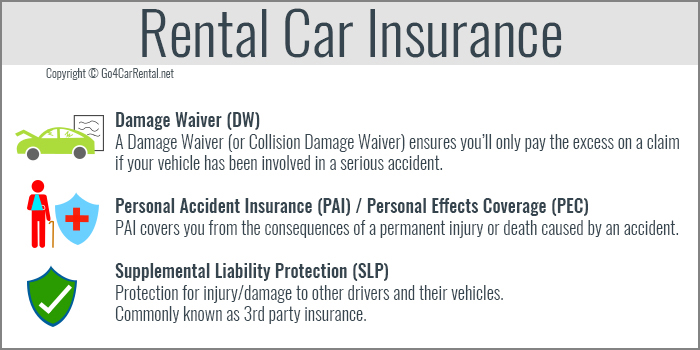
Car Rental Damage
In an ideal world, the auto vehicle renter could save themselves a pretty penny by just paying the basic fees and a deposit and driving off into the sunset, but most of us will err on the side of caution and grab some additional insurance.
How much you want and how much you actually need are determined by a whole range of factors and you’ll probably find yourself handing back the car keys with one policy too many.
However, if you do need to make a claim, you’ll be required to contact the car rental company and the underwriters of their insurance company who will guide you through the process.
Car Hire Kilometres / Mileage Rules
With limited kms/mileage, there is usually a basic fee for each day you rent the vehicle but if you exceed the set mileage, you’ll be charged additional fees.
Unlimited kms/mileage means just that (but do check) but you may have to pay extra for the privilege; it’s worth bearing in mind that it may be the better option if you are unsure of the total number of kms/miles that you’ll be traveling per day.
One Way Car Rental
Many car rental agencies will allow you to pick up a hire vehicle in one location and drop it off in another location.
Fees are usually calculated on the costs of returning the rental vehicle to its original location, so this fee will rise with distance and will increase if returning to a depot in a different country.
Here are two examples of the additional fee for a one way rental (based on trip distance):
Short Distance (1000Km / 620Mi) – Approximately US$0.00 to US$200 or more*
Long Distance (3000Km / 1800Mi) – Approximately US$0.00 to US$1,000 or more*
*The above prices are purely examples. Prices will vary between rental car companies, locations and availability of vehicle types, so it’s best to obtain an accurate quote using our car hire search box at the top of this page.
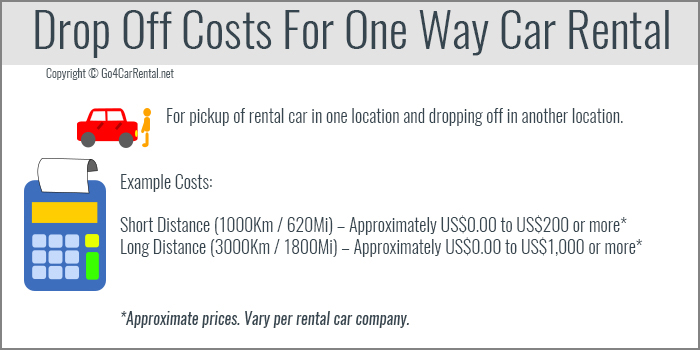
Roadside Assistance
What do I do if I’ve had a breakdown in a hire car?
Car rental companies will generally offer roadside assistance through a third-party provider as part of their service, but fees will accompany this service.
A roadside assistance phone number is usually visible on a sticker on the inside of the windscreen/windshield (on the drivers side). So if you have a breakdown, look there first.
If it’s not there, it will be in the paperwork given to you by the car hire company.

In an extreme circumstance, if you can’t get hold of the rental company or if there’s some other holdup and you want to get your family off the side of the road (along with your valuable belongings), take the bull by the horns and call a tow truck to pick up the vehicle and take it to a nearby mechanic of your choosing, or ask the two truck company to recommend a trustworthy mechanic.
You may have to pay up front out of your own pocket for such costs, but you can put in a claim with your car insurance company to be refunded for this.
Your safety, your family’s safety and the safety of your belongings is more important than anything, so don’t rely too heavily on other companies and people in such circumstances.
Paying Fees And Fines For a Hire Car
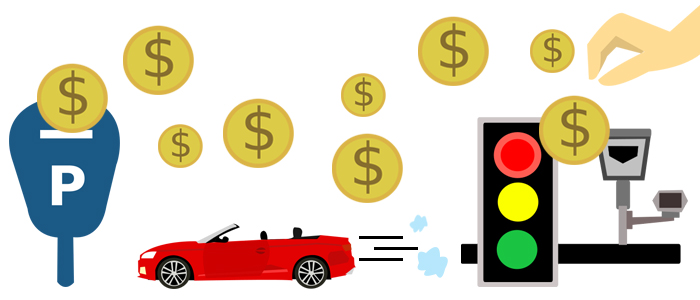
Parking fees – these are linked to the car registration number, which is linked to the car hire company. So if you get a parking fine, you’ll get the bill… eventually.
Speeding fines – if you get caught for speeding by a camera, the bill will be sent to the car hire company, and they’ll then pass it onto you for payment, eventually.
If you get pulled over by a police officer for speeding, they’ll record your registration number and drivers license number, which will link back to your car hire company.
To avoid incurring extra fees, you’re best best is to take the fine and see where you can pay the fine in person (either at a local police station or at a local municipal office).
If you pay the fine before you leave town, you’ll avoid extra administration fees charged by the car rental company for the extra paperwork they had to handle on your behalf.
Red light cameras – just like with speed camera fines, if you run a red light, the fine will be sent to the car hire company and eventually on to you.
If you know that you’ve been caught by a speeding camera or a red light camera, call your car hire company ahead of time and notify them.
It just might save you an administration fee if you can pay the fine sooner.
What’s Not Included When You Hire a Car?
When you rent a car you’re responsible for the following costs above and beyond the hire of the vehicle itself:
- Fuel
- Parking fees (at your hotel or general municipal street parking)
- Valet tips
- Fines (parking, speeding, etc)
- Road tolls (these can sometimes be paid in advance, or will be sent later as a bill from the car hire company)
- Multiple drivers – if you have more than one driver, you may need to pay extra per day for the privilege.
- Additional insurance – such as young driver cover, no-excess cover, etc.
- Extra kilometres / mileage – some companies will allocate a number of allowed kilometres/miles per day. Check the fine print to see if there’s any restrictions of kilometres/miles in order to avoid additional fees.
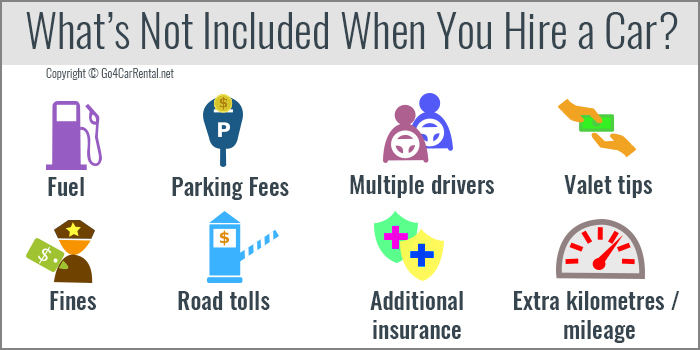
Modifying Your Car Rental Booking
Making a change to your original booking is likely to alter the original agreed price. Depending on the modification, you may or may not be charged a fee.
Common booking changes can include:
Hire dates – if you change the dates of your car hire several days out from pickup, you likely won’t be charged for this. However, if you change your dates within 24 or 48 hours, you’ll likely be charged for this last minute change. Ask at the time of changing if there’s a fee.
Vehicle type – if you want to change your booking from a hatchback to a SUV, there’s going to be an increase in the cost of renting due to the upgrade in the size of vehicle.
However, if you change from an SUV down to a hatchback, your cost per day to hire the vehicle will be lower. If you arrange this change several days prior to pickup, it won’t likely incur a fee.
If you change your mind upon pickup of the vehicle or a day after you’ve been driving around, there will be a fee involved or they simply may not have a vehicle available for you.
When it comes to modifying your booking, try to do it as far in advance as you can to avoid not just additional fees but also disappointment.
Which Side Of The Road Do I Drive On?

In most countries people drive on the right-hand side, so here is a definitive list of all the countries that drive on the left-hand side:
Africa: Kenya, South Africa, Zimbabwe, Lesotho, Botswana, Malawi, Zambia, Namibia, Swaziland, Uganda, and Tanzania.
Asia: Hong Kong, India, Brunei, Bangladesh, Bhutan, Malaysia, Pakistan, Singapore, Indonesia, and Sri Lanka.
Australia and Oceania: Australia and its territories including Christmas Island, Cocos Islands and Norfolk Island. New Zealand and its territories (The Cook Islands and Tokelau) Fiji, Pitcairn Islands, Kiribati, Tuvalu, Niue, Nauru, Samoa, Papua New Guinea, Tonga, and Solomon Islands.
Europe: UK, Guernsey, the Isle of Man, Ireland, Malta, and Cyprus.
West Indies: Anguilla, Turks and Caicos Islands, Montserrat, Cayman Islands, British Virgin Islands, Saint Kitts and Nevis, Jamaica, Trinidad and Tobago, Saint Vincent and the Grenadines, Barbados, Saint Lucia, Bahamas, Antigua and Barbuda, Dominica, Grenada and the U.S. Virgin Islands.
What Are The Road Rules In Each Country?
Road rules vary from country to country, from what most people would consider normal, right through to ‘weird’ driving laws.
In Japan it’s against the law to splash a pedestrian when driving through standing water, and in Thailand, it’s forbidden to drive a vehicle of any kind without a shirt; and in Denver, Colorado it’s illegal to drive a black car on a Sunday.
However strange they may sound, don’t provoke the local police by breaking any local laws. You’re on holiday to have a good time, so just do the right thing to avoid fines and other potential issues.
USA
In the USA motorists drive on the right-hand side of the road, white lines separate traffic traveling in the same direction, yellow lines separate traffic going in the other direction. A ‘stop’ sign means you must physically stop before continuing your journey and so long as you’ve clear access, you can turn right on a red light. Read more about USA road rules.
Canada
In Canada motorists drive on the right-hand side of the road. Drivers must carry a valid driver’s license, registration and insurance documents at all time. Read more about Canadian road rules here.
UK
In the UK motorists drive on the left, give way for pedestrians at crossings and every passenger must wear a seat belt. Beware of low-emission zones in capital cities, failure to do so can result in fines. Read more about UK road rules here.
European Union
Apart from the United Kingdom, Ireland, Malta and Cyprus, all countries drive on the right. Many of these require you to keep your lights on day or night, especially in the North, and all have strict alcohol limits. Read more about European road rules here.
Australia
In Australia they drive on the left, so if you’re traveling slowly you keep left. Beeping your horn should only be used when warning other motorists of danger, not to catch the attention of an old school buddy. Read about Australian road rules here.
New Zealand
Another left-hand driving country with strict speed limits and as in the USA, a ‘stop’ sign means just that. The roads are undulating with a lot of corners, so ensure you slow down before making that turn. Read about New Zealand Road Rules here.

Renting a Car In The USA: What You Need To Know

Car rental agencies have desks at every international airport in the US, as well as at most regional airports.
The convenience of an airport rental car in the USA comes with a price, though, and in larger USA cities you may find a better deal if you pick up your car in town instead.
One-way rentals, in which you return the car at a location different from where you picked it up, may be available if you are traveling between major cities.
All rental agencies have websites and it’s easy to shop around and make a reservation online.
Available options include big name companies like Hertz and Avis, which offer a variety of vehicles from compact to luxury.
Enterprise will famously pick you up from your lodging and drive you to their office. Smaller but still reputable companies like Rent-a-Wreck offer older cars at a good price, although they are not as widely available.
You’ll need a valid driver’s licence and a major credit card to rent a car.
It’s a good idea to bring an International Driving Permit (IDP) no matter where you’re from, and it’s essential if your licence is not in English. You’ll probably be asked for your passport as well.
The usual minimum age for renting a car in the USA is 21, although in some states it is 18.
Extra charges for drivers under 25 are to be expected, and younger drivers may be limited to certain car models. Regardless of age there will be additional charges for more than one driver.
Most rentals will include a full-to-full fuel policy, in which you are expected to return the car with the same amount of fuel it had when you picked it up.
If you don’t, you can expect to be charged a hefty fee for the agency to refill the tank.
Appropriate child seats are required in every state for infants, toddlers and younger children, and every car rental agency will have them available for a fee.
GPS units are also commonly available, some with special features customized to the rental company.
To ensure availability, it’s a good idea to request child seats and GPS units when making a reservation, especially during peak travel times.
Renting a Car In Canada: What You Need To Know

Car rental agencies have desks at most Canadian airports. The convenience of an airport rental car in Canada comes with a price, though, and in larger cities you may find a better deal if you pick up your car in town instead.
One-way rentals, in which you return the car at a location different from where you picked it up, may be available if you are traveling between major cities.
Some companies place restrictions on travel between Canadian provinces or across the border into the US.
All rental car agencies in Canada have websites and it’s easy to shop around and make a reservation online.
Available options include big name companies like Hertz and Avis, which offer a variety of vehicles from compact to luxury. Enterprise will famously pick you up from your lodging and drive you to their office.
You’ll need a full driver’s licence that you have held for at least one year to rent a car in Canada.
It’s a good idea to bring an International Driving Permit (IDP) if you don’t have a Canadian or US licence, and it’s essential if your licence is not in English. You may be asked for your passport as well.
A major credit card (Visa, Mastercard, American Express or Discover) is required to pick up a rental car at a Canadian airport.
Some non-airport locations will accept debit cards at pick up, but they are likely to require additional documentation such as utility bills, paycheck stubs and personal references.
The usual minimum age for renting a car in the Canada is 21, although it may be 18, 19 or 20, depending on province and rental company.
Extra charges for drivers under 25 are to be expected, and younger drivers may be limited to certain car models.
There is no maximum age for renting a car in Canada. Regardless of age there will be additional charges for more than one driver.
You may have several choices of fuel policies, depending on the rental company.
These include returning the car with the same amount of fuel it had when you picked it up, returning it with less and paying an above-market price for the shortage, and paying ahead for a full tank.
If you pay ahead you can return the car with an empty tank, but you won’t receive credit for any fuel you leave in it.
Appropriate child seats are required in every province for infants, toddlers and younger children, and every car rental agency will have them available for a fee.
GPS units are also commonly available, some with special features customized to the rental company. To ensure availability, it’s a good idea to request child seats and GPS units when making a reservation, especially during peak travel times.
Renting a Car In Australia: What You Need To Know
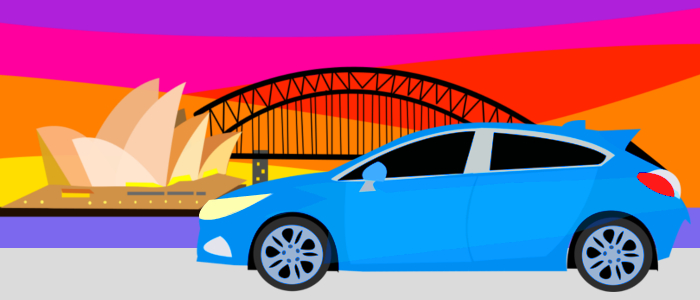
Car rental agencies have desks at airports and cities throughout the country in Australia.
One-way rentals, in which you pick the car up in one location and return it to another, are readily available.
Some companies offer great deals on one-way relocation rentals when they need vehicles moved from place to place.
Major rental agencies have their own websites and rental aggregators allow you to compare rates among companies of all sizes.
Available options include big name companies like Hertz and Avis, which offer a variety of vehicles from compact to luxury. There are a number of country-specific Australian rental companies as well.
You’ll need a full valid driver’s licence to rent a car in Australia. It’s a good idea to bring an International Driving Permit (IDP) if your licence is not in English. You will also need your passport or national ID card.
Car rental companies typically prefer you pay by credit card, and this can be to your advantage if your card offers additional insurance coverage.
However, in Australia it may be possible to pay with a Visa or MasterCard debit card. A few companies may accept cash payments if stringent requirements are met and arrangements are made in advance.
The minimum age for renting a car in Australia is usually 21, but it varies from 18 to 25 depending on the rental company and model of car.
Extra charges for drivers under 25 are common, and younger drivers may be limited to certain car models.
There is usually no upper age limit for renting a car, but some companies may require a medical certificate for drivers over 75. Regardless of age there will be additional charges for more than one driver.
Some very large areas of Australia are lightly populated and lack basic services; travel in these areas requires careful planning.
Ferry travel with a rental vehicle is usually not allowed, meaning you cannot take your rental to Tasmania or New Zealand. Your rental agency may have limitations on driving in Western Australia and the Northern Territory.
Most rental cars in Australia have automatic transmissions, and they are no more expensive than those with manual transmissions, which may be hard to find.
You may have several choices of fuel policies, depending on the rental company.
These include returning the car with the same amount of fuel it had when you picked it up, returning it with less and paying an above-market price for the shortage, and paying ahead for a full tank.
If you pay ahead you can return the car with an empty tank, but you won’t receive credit for any fuel you leave in it.
Everyone in your car must wear a seat belt. Laws on child seats may vary by state, but appropriate child restraints are generally required for children under the age of 12 and car rental agencies will have them available for a fee.
GPS units are also commonly available, some with special features customized to the rental company. To ensure availability, it’s a good idea to request child seats and GPS units when making a reservation, especially during peak travel times.
Renting a Car In New Zealand: What You Need To Know

Car rental agencies have desks at airports, the Greymouth railway station, the Picton ferry terminal and throughout the country in New Zealand.
Some companies will meet you at a train, ferry or bus station or pick you up from your lodging.
One-way rentals, in which you return the car at a location different from where you picked it up, are often available.
Major rental agencies have their own websites and rental aggregators allow you to compare rates among companies of all sizes.
Available options include big name companies like Hertz and Avis, which offer a variety of vehicles from compact to luxury.
There are a number of country-specific New Zealand rental companies, and many of these cater to budget travelers with older, less reliable vehicles.
You’ll need a full valid driver’s licence to rent a car in New Zealand. It’s a good idea to bring an International Driving Permit (IDP) if your licence is not in English. You may be asked for your passport as well.
Car rental companies typically prefer you pay by credit card, and this can be to your advantage if your card offers additional insurance coverage.
However, in New Zealand it may be possible to pay with a debit card, provided it is in the primary driver’s name and has embossed numbers. Some locations will accept only Visa and Mastercard debit cards.
Generally, the minimum age for renting a car in New Zealand is 21, but some companies will allow drivers as young as 18.
Extra charges for drivers under 25 are common, and younger drivers may be limited to certain car models.
There is usually no upper age limit for renting a car, but some companies may require a medical certificate for drivers over 75. Regardless of age there will be additional charges for more than one driver.
Rental cars are usually not permitted on the ferry between the North and South Islands.
If you want to tour both islands, you will be offered a multi-island rental. With this arrangement you will turn in your car before boarding the ferry and the rental company will have another car waiting for you when you disembark.
Most rental cars in New Zealand have automatic transmissions. Manual transmission vehicles are getting harder to find and may be more available from companies with older fleets.
You may have several choices of fuel policies, depending on the rental company. These include returning the car with the same amount of fuel it had when you picked it up, returning it with less and paying an above-market price for the shortage, and paying ahead for a full tank.
If you pay ahead you can return the car with an empty tank, but you won’t receive credit for any fuel you leave in it.
Everyone in your car must wear a seat belt. Appropriate child restraints are required for children under the age of 7, and most car rental agencies will have them available for a fee.
GPS units are also commonly available, some with special features customized to the rental company. To ensure availability, it’s a good idea to request child seats and GPS units when making a reservation, especially during peak travel times.
Renting a Car In the UK: What You Need To Know

Car rental agencies have desks at every major airport and railway station in the UK.
The convenience of a transportation hub rental comes with a price, though, and in larger cities you may find a better deal if you pick up your car in town instead.
One-way rentals in the United Kingdom, in which you return the car at a location different from where you picked it up, may be available if you are traveling between major cities.
Major rental agencies have their own websites and rental consolidators allow you to compare rates among companies of all sizes.
Available options include big name companies like Hertz and Avis, which offer a variety of vehicles from compact to luxury. Enterprise will famously pick you up from your lodging and drive you to their office.
Some areas have smaller, local rental companies, and in some remote areas local companies are the only option.
You’ll need a full driver’s licence that you have held for at least one year to rent a car in the UK.
It’s a good idea to bring an International Driving Permit (IDP) if you don’t have a UK, Australian or USA licence, and it’s essential if your licence is not in English. You may be asked for your passport as well.
Car rental companies in the UK typically prefer you pay by credit card, and this can be to your advantage if your card offers additional insurance coverage.
However, in the UK it may be possible to pay with an American Express, Visa, Mastercard, Diners Club, JCB or Discover debit card, provided it is in the primary driver’s name and was issued by a bank in the driver’s country of residence.
The minimum age for renting a car in the UK is 21. Extra charges for drivers under 25 are common, and younger drivers may be limited to certain car models.
Some companies may have upper age limits of 70 or 75, although this is not common in the UK. Regardless of age there will be additional charges for more than one driver.
Rental cars in the UK mainly have manual transmissions. Automatic transmission vehicles are available and you may pay a little more for them in rental fees.
You may have several choices of fuel policies, depending on the rental company. These include returning the car with the same amount of fuel it had when you picked it up, returning it with less and paying an above-market price for the shortage, and paying ahead for a full tank.
If you pay ahead you can return the car with an empty tank, but you won’t receive credit for any fuel you leave in it.
Appropriate child seats are required for children until they are 12 years old or 135 cm (53 in) in height, and every car rental agency will have them available for a fee.
GPS units are also commonly available, some with special features customized to the rental company.
To ensure availability, it’s a good idea to request child seats and GPS units when making a reservation, especially during peak travel times.
Renting a Car In Ireland: What You Need To Know

Car rental agencies have desks at airports in Ireland as well as various locations around the country.
While usually picking up a car at an airport is more expensive than picking one up in town, in Ireland the opposite may be true.
One-way rentals, in which you return the car at a different Irish location from your pick up point, may be available.
Major rental agencies have their own websites and hire companies allow you to compare rates among companies of all sizes.
Available options include big name companies like Hertz and Avis, which offer a variety of vehicles from compact to luxury.
Enterprise will famously pick you up from your lodging and drive you to their office. Ireland has several country-specific car rental companies as well.
You’ll need a full driver’s licence that you have held for at least one year, or two years if you’re under 25.
It’s a good idea to bring an International Driving Permit (IDP) if you don’t have licence from the UK, US, Canada, Australia or EU, and it’s essential if your licence is not in Roman script. You may be asked for your passport as well.
You’ll generally need a major credit card in the primary driver’s name to rent a car in Ireland. Some companies will accept debit cards under certain conditions. Cash is not accepted.
Very few credit cards cover rental car insurance in Ireland. If yours does, you should bring a letter from the credit card company confirming this. If it doesn’t, you may be compelled to purchase very expensive insurance from the rental company.
The minimum age for renting a car in Ireland is 21. Extra charges for drivers under 25 are common, and younger drivers may be limited to certain car models.
Some companies will charge extra for drivers over 70 and will not allow them to rent larger vehicles; some will not rent at all to drivers over 75. Regardless of age there will be additional charges for more than one driver.
Most rental cars in Ireland have manual transmissions. Automatic transmission vehicles may be harder to find and you will pay considerably more for them, both in rental fees and in fuel costs.
You may have several choices of fuel policies, depending on the rental company.
These include returning the car with the same amount of fuel it had when you picked it up, returning it with less and paying an above-market price for the shortage, and paying ahead for a full tank.
If you pay ahead you can return the car with an empty tank, but you won’t receive credit for any fuel you leave in it.
Your rental agency may charge an additional fee to extend your insurance coverage if you plan to cross the border into Northern Ireland.
If you don’t arrange this ahead of time you may not be covered in the event of accident, damage or theft.
The border isn’t always clearly marked and it’s important to remember speed limits in Ireland are posted in kilometers per hour, but in Northern Ireland they are posted in miles per hour.
Ireland’s laws on cell phone usage are stricter than those in many other countries.
You may not hold or support a mobile device with any part of your body while driving, or touch it to access any kind of information.
Using voice-activated, hands-free devices is legal but discouraged, and you may be considered at fault if you are in an accident while doing so.
Even with a hands-free device you may not send texts or emails or browse the internet while driving.
Everyone in your car must wear a seat belt. Children under 150 cm (59 in) tall or weighing less than 36 kg (79 lbs) must be secured in an appropriate child seat, and car rental agencies will have them available for a fee.
Some companies, however, will not supply rear-facing infant seats and require you to provide your own. GPS units are commonly available, some with special features customized to the rental company.
To ensure availability, it’s a good idea to request child seats and GPS units when making a reservation, especially during peak travel times.
Renting a Car In Europe: What You Need To Know

Car rental agencies have desks at major airports in all European countries, and in some countries pickup can be arranged at train stations, ferry terminals and in and around towns and cities.
It’s usually more expensive to pick up a car at an airport than in town, but this isn’t always the case.
One-way rentals, in which you return the car at a location different from where you picked it up, are more widely available in some countries than others.
Major rental agencies have their own websites and rental aggregators allow you to compare rates among companies of all sizes.
Available options include big name companies like Hertz and Avis, which offer a variety of vehicles from compact to luxury.
There are a number of smaller country-specific car rental companies as well; these are sometimes represented by aggregators but some have to be contacted directly.
You’ll usually need a full driver’s licence that you have held for at least one year to rent a car in Europe, although in some places you will need to have had your licence for two years, especially if you’re under 25.
It’s a good idea to bring an International Driving Permit (IDP) if your licence is not in Roman script, and in some places an IDP may be required. You may be asked for your passport as well.
You’ll generally need a major credit card in the primary driver’s name to rent a car in Europe. Some companies will accept debit cards under certain conditions. Cash is sometimes accepted, but this must usually be arranged in advance and there may be additional requirements.
If you plan to rely on your credit card’s rental insurance, consider bringing a letter from the bank confirming the coverage.
The minimum age for renting a car in Europe is variable and generally ranges from 18 to 25.
Extra charges for drivers under 25 are common, and younger drivers may be limited to certain car models. In some countries upper age limits may be enforced.
Companies may charge additional fees for older drivers, require them to produce medical certificates, limit which vehicles they can drive or refuse to rent to them at all. Maximum age limits range from 70 to 97.
Most rental cars in Europe have manual transmissions. Automatic transmission vehicles may be harder to find and you will pay considerably more for them, both in rental fees and in fuel costs.
You may have a choice between diesel- or petrol-powered vehicles, and whichever you drive you’ll need to be mindful to choose the correct nozzle at the fuel pump.
You may have several choices of fuel policies, depending on the rental company.
These include returning the car with the same amount of fuel it had when you picked it up, returning it with less and paying an above-market price for the shortage, and paying ahead for a full tank.
If you pay ahead you can return the car with an empty tank, but you won’t receive credit for any fuel you leave in it.
If you plan to drive in more than one country, be sure to check the rental company’s policy on crossing borders.
Border crossings may require advance notice, may incur additional charges and may be prohibited altogether.
Laws limiting the use of cell phones and other mobile devices while driving are becoming more common in Europe.
Voice-activated, hands-free devices are usually legal but their use may be discouraged. In some countries it may be illegal to hold or touch mobile devices while driving.
Seat belts are required in most European countries, and children under certain ages, heights or weights usually must be secured in appropriate child seats.
Most car rental agencies will have child seats available for a fee. Some companies, however, will not supply rear-facing infant seats and require you to provide your own.
GPS units are commonly available, some with special features customized to the rental company.
To ensure availability, it’s a good idea to request child seats and GPS units when making a reservation, especially during peak travel times.
Renting a Car In Asia: What You Need To Know

Availability of rental cars in Asia varies widely from one country to another. Larger cities may have rental agency desks at airports and in town but some do not, and this is subject to change.
The experience of driving in Asian countries can be so difficult for Westerners that they may be actively discouraged from trying to do so. You may consider hiring a car with a local driver included.
Big name companies like Hertz and Avis do have offices in many Asian countries, although their price structure and other policies will be based on local custom. Each country has its own country-specific rental companies as well.
You will usually need a full driver’s licence that you have held for at least two years to rent a car in Asia.
It’s a good idea to bring an International Driving Permit (IDP), and it’s essential if your licence is not in Roman script. In some Asian countries you must obtain a local licence before you can drive.
This may be as simple as paying a fee, but you may have to pass a test as well. You should be prepared to present your passport and, if applicable, your visa.
You’ll almost certainly need to pay with a major credit card in the primary driver’s name, and many companies will only take Mastercard or Visa.
Debit cards and cash are generally not accepted. Required deposits for rental cars may run into thousands of dollars.
The usual minimum age for renting a car in Asia varies from 21 to 23, and for larger vehicles may be as high as 30.
Extra charges for drivers under 25 are common, and younger drivers may be limited to certain car models. Some companies may have upper age limits of 65, 70 or 75.
Charges for additional drivers may run hundreds of dollars per day; it may be cheaper to rent a car that comes with a driver.
Most rental cars in Asia include unlimited mileage, but this may not include travel to other countries. It’s important to clarify your rental company’s policy on crossing borders before heading out, as penalties may be severe.
You may or may not have a choice of fuel policies, depending on the company.
The full-to-full policy, in which you agree to return the car with the same amount of fuel it had when you picked it up, is most common.
Returning it less than full means paying an above-market price for the shortage, and possibly additional fees as well.
Sometimes you can pay ahead for a tank of fuel and return the car empty, although you won’t receive credit for any fuel you leave in it.
Use of seatbelts and child restraints is not a given in many Asian countries, although rental companies are likely to have some kinds of child seats for hire.
To help ensure availability, it’s a good idea to request child seats and GPS units when making a reservation.
We’ve listed these questions and answers on our car rental FAQ page…
Picking Up a Hire Car At An Airport: Rules And Requirements
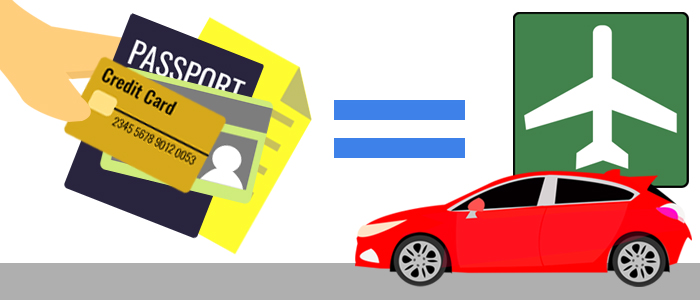
Airports are busy places, so while you’re waiting to speak to a rental car representative take the time to get your paperwork in order.
At the counter, you’ll be asked if you have a reservation and you’ll be guided from there.
- You’ll be asked for your drivers license, proof of identity (passport or ID) and a credit card in the name of the main driver.
- You may well be asked for an international driving permit where applicable (obviously you’ll have checked if this applies to you) and proof of a ‘round trip’ which could be flight, cruise or train tickets, essentially, evidence that you intend to return the vehicle as agreed.
- If you haven’t pre-booked, this is the moment you’ll pay for your car and any ‘extras’ you may require, such as a baby seat or a GPS.
- At about this time you’ll have to decide which optional, extra, insurance you intend to purchase, if any. It’s advisable to have made this decision at the time of booking your rental car; similar advice applies to offers to upgrade your vehicle.
- Take time to read the car hire agreement before signing.
- Make sure you gather all of the rental car documents together and put them in a safe place.
- Once done you’ll be handed the keys to the rental car and either shown or directed to where you can find it. Remember, hire cars spend nearly all of their driving lives in the open and are arguably more vulnerable to damage, so take photographs of all the knocks and scrapes, inside and out, and if there are any discrepancies between what’s on the paperwork and what’s on the car, inform a member of staff before you drive away.
Crossing a Country Border In a Hire Car
If you’re intending to drive your rental car into another country you need to inform the car hire company in advance as travel between some countries (USA and Mexico, South American and African countries, for example) require additional paperwork that may take time to collate.
Failure to inform your rental car company that you’re traveling between countries can invalidate any existing insurance and/or contravene your agreement with the hire car company.
Finally, you may or may not be required to pay a fee for the privilege of driving across a border so always check ahead.
Popular Car Rental Brands
There are literally hundreds of car rental companies dotted all over the globe, but only a handful are household names.
Here are a few of the most popular rental car companies that have built strong brands and reputations over decades of service…

Alamo
Founded in 1974 in Florida, since 2016 Alamo been owned by Enterprise, one of the largest car rental operators in the world.

Avis
Founded in 1946 in Michigan, Avis were the first car rental company to be located at an airport, in less than a decade they were the second largest car rental company in the USA.
In 2006 they became part of the Avis Budget Group, the same group that owns Budget, Payless, Apex and Zipcar, but still trading under the Avis name.
With franchises operating all over the US and Canada, they’re the leading general-use vehicle renting company in North America, Australia, New Zealand, Mexico, South America, India and Europe.

Budget
Founded in Los Angeles in 1958, Budget lived up to their name by undercutting the rates of their competitors and gaining a foothold in the market.
From 1986 the group were bought and sold by no less than four companies eventually becoming a part of the Avis group, but still operating under the Budget name.

Europcar
Founded in France 1949, and now operating in 140 countries throughout Europe, North America, Western Asia and Africa, Europcar were bought by Eurazeo in 2006 and have been growing since.

Enterprise
Founded in 1969 in Missouri, Enterprise is the largest car rental company in the USA with over 9000 locations in cities over the country with a further 419 in airports across the United States, Canada, UK, Spain, Germany and Ireland.

Hertz
Founded in Chicago in 1918, Hertz is the second largest US car rental provider, with well over 10,000 international franchise locations in over 150 countries across the world.

National Car Rental
Founded in the USA in 1947 by a collective of 24 independent car rental agents, National later acquired a foothold in Canada after purchasing Tilden Rent-a-Car in 1996, but since 2007 have been owned by Enterprise.
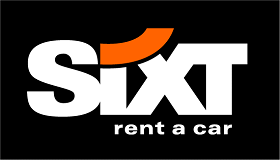
Sixt
The first rental car company founded in Germany 1912, and still the largest in its country of origin, Sixt has around 5000 locations in 150 countries across the world.
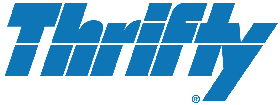
Thrifty
A subsidiary of Hertz (and formerly operating as Dollar Thrifty Automotive Group) Thrifty has 1500 franchise rental and 340 corporate locations spread over the US and Canada.
Popular Drive Destinations By Country
The world is rich with roads that wind their way through some of the most beautiful places on earth, some familiar, others not so.
The secret of great road trips is in the journey, so before you reach your destination, relax, take in some stunning views and just enjoy the ride.
USA Popular Driving Routes:

Route 66, The Pacific Coast Highway, Great River Road… The states are the spiritual home of the auto rental, discover why.
Blue Ridge Parkway
Miles of glorious road spanning Virginia and North Carolina, the Blue Ridge Parkway offers an unparalleled view the world-famous Blue Ridge Mountains. Singing alone to Laurel and Hardy’s classic as you cruise in your rental car is mandatory.
Pacific Coast Highway
This trip is one of the most spectacular anywhere in the USA, it’s basically Highway One from San Francisco then onto the Pacific Coast Highway all the way to Los Angeles. If the ocean is to the right of you, you’re going the right way.
Route 66
Aka the Will Rodgers Highway, this legendary road that runs from Chicago to California is more than the sum of its parts. Route 66 has been immortalised in music and literature and cuts through the very heart and soul of the USA. Unmissable.
Yosemite National Park
Arguably the most famous national park in America, nestling in the Sierra Nevada mountains in North California, Yosemite National Park offers scenic roads wind past ancient sequoia forests, waterfalls and granite cliffs. A feast for the eyes from the comfort of your own rental car.
Canada Popular Driving Routes

Open and inviting, the Cabot Trail is just one of the dozens of epic road adventures.
Hot Springs Circle
While away the hours at Hot Springs Circle passing through huge swathes of beautiful British Colombian countryside with plenty of enticing places to stop and take it all in. Pick from a host of shorter journeys to and from designated locations or, better still, do the whole circle.
Icefields Parkway
The road runs from Lake Louise in Banff National Park to Jasper in Jasper National Park, the Icefields Parkway is regarded as one of the most beautiful drives anywhere in the world. That’s some claim, why not rent a car and go and discover for yourself. PS. It is.
Sea to Sky Highway
Vancouver to Pemberton, an unforgettable 163.13 km/101.36 miles of glorious open road that you can enjoy over a long weekend. Sea to Sky Highway offers loads of places to stop to enjoy the eye-popping scenery, this is one of the best ways to experience a car hire/rental.
Australia Popular Driving Routes

A huge country with numerous great drives, The Great Ocean Road and Snowy Mountain Drive are a mere two from a list almost as vast as Australia itself.
Great Ocean Road
The Great Ocean Road relatively short (243-kilometre/151 mile) stretch of road along the south-eastern coast of Australia is nothing short of sublime. You’ll be boring your neighbour’s rigid with this one for years.
Snowy Mountains Drive
The Snowy Mountains Drive features a number of amazing routes that criss-cross the snowy mountains featuring miles of beautiful scenery, deep green valleys and endless plains. Try and pick a favourite.
New Zealand Popular Driving Routes

Boasting some of the best scenery in the world it’s hard to go wrong, start with Arthur’s Pass and The Lost World Highway, then do them all.
Alpine Pacific Triangle
There are so many activities and aspects to explore on the Alpine Pacific Triangle it’s hard to know where to start: hot-springs, marine animals, theme parks, indulgent food, all connected by a truly magnificent stretch of road. Make sure you plan this one out before you rent your car.
Classic Wine Trail
New Zealand is a relative newcomer to wine, now rated as some of the best in the world. In addition to driving through incredible scenery, the Classic Wine Trail will take you through some of the finest wineries in the country. Ensure you’re meticulous in planning stops, wine and rental cars don’t mix.
Milford Road
Milford Road is a candidate for one the of the best mountain drives anywhere in the world, and arguably worth the trip just to gaze at the aptly named Mirror Lakes, and you’ll probably need a lie down after experiencing the Avenue of the Disappearing mountains. Sensational.
Southern Scenic Route
Go ahead, take the month off, you simply can’t rush the Southern Scenic Route; from glaciers to beaches, forests to lakes all featuring National Geographic examples of wildlife, this is 610 kilometres/380miles of scenic road that virtually defy description. Just do it.
South Africa Popular Driving Routes

With all road surfaces catered for, you’re never going to have a problem finding adventure in South Africa, The Wupperthal Road, in the Western Cape is a journey back in time…
Chapmans Peak Drive
Chapmans Peak Drive, aka “The Chappies”, isn’t for the faint-hearted, but if you’re a confident driver with a head for heights then this should be at the top of your bucket list: a table-top road cut into the side of a mountain snaking past the coastline, just awesome.
Garden Route
If the Chappies is a bit much, then the Garden Route is for you. A coastal drive that takes you to some of the most beautiful beaches and coves anywhere in the world, flanked by mountains and forests teeming with wildlife. It’s where South Africa goes on holiday.
Sani Pass
This one is off limits to all but the most experienced drivers. For the Sani Pass You’ll need to rent a 4×4 and be prepared to drive in fast-changing weather conditions. The brave will be rewarded to a life-affirming experience. Do your research first. And good luck.
France Popular Driving Routes

The French Rivera is on many a drivers’ bucket list but don’t forget to head to the mountains, journey along the Route des Grandes Alpes and make some lifelong memories.
Alsace Wine Route
The Alsace Wine Route isn’t just about the obvious, it’s about fairy-tale villages, beautiful and scenery and then factoring in the world-famous wine and food. Ensure you’ve secured your accommodation well in advance, drinking and driving is strictly forbidden.
Col de Turini
This mountainous region of outstanding natural beauty forms part of the Monte Carlo Rally, which gives a good idea of what to expect in terms of driver competence. The Col de Turini is classed as one of the most scenic in the world it’s also one of the most dangerous in poor conditions.
Italy Popular Driving Routes

Most European countries boast of a handful of great drives, in Italy you’re hard pressed to find a bad one, really. Enjoy…
Amalfi Coast Road
The Amalfi Coast Road is a short, sweet and thrilling, a winding, undulating road that takes you through some of the most beautiful scenery in Italy. Mountains, forests and coasts all feature in a sort of miniature-road-trip of a lifetime.
Great Dolomite Road
You’ll need to be an experienced, proficient driver to tackle the famous Great Dolomite Road that literally cuts through the Dolomites as some of the hairpin sections are very steep, but you’ll also be treated to one of the most inspiring rooftop views in the world.
Tuscany
Tuscany is almost 23,000 sq kilometres/13300 miles of Italian perfection, with Florence, one of the world’s most beautiful cities, as its capital. Did I mention the Apennine Mountains, the sunny beaches of Elba that kiss the Tyrrhenian Sea? The food isn’t too bad either…
Ireland Popular Driving Routes

So underrated as a place for some spectacular driving roads, it’s almost as if the locals don’t want you to know! Try the less traveled Copper Coast Route to get into the swing of things and go from there.
Causeway Coastal Route
The Giants Causeway is a UNESCO World Heritage site for good reason and while it’s a must-see attraction, the coastal route is a trip not to be missed. Castle ruins, sandy beaches and green hills punctuate this glorious coastline, go and enjoy it.
UK Popular Driving Routes

For the best in British driving, head up North and discover the beautiful Lake District or plan a road trip to visit the numerous castles and building that have helped shaped modern day Britain.
Atlantic Highway
Running from Tiverton to Carland Cross, the Atlantic Highway road trip can be undertaken in a day, or over a weekend if you’re planning on taking in the beaches, surrounding countryside or a leisurely visit to Tintagel Castle, home to the legendary King Arthur.
Cotswolds
The kidney-shaped scenic-road running in the Cotswolds, an area of outstanding beauty between Oxford and Bristol is populated by film set villages that wind through postcard versions of English countryside. Quant, romantic and timeless.
Lake District
Choose from over a dozen scenic drives in the Lake District that trickle through one of the UK’s finest National Parks, all of them enjoying the landscaped vista of at least one of the sixteen lakes that lie silently in this mountainous region of north-west England.
Loch Lomond to Glencoe
An awe-inspiring ride on the A82 from the eerily beautiful Loch Lomond through mountainous country dotted with castles, parks and beaches until arriving at Fort William in the shadow of Ben Nevis, the UK’s tallest mountain.
Top Driving Guide Websites
One of the best things about renting a car is that you’re pretty much free to travel virtually anywhere you want. That means that for every trip you can think of there will be a hundred more left unconsidered.
Why not have a click around these top travel blogs for awesome driving routes and road trips to tick off your bucket list.
And checkout some of the top road trip planner apps here that will keep you on track, provide invaluable weather updates, help you find accommodation and just about anything else you can think of!
Furkot is a one-stop shop for maps and travel all over the US.

Hand Luggage Only is a Europe-centric website for the discerning traveler. With so many amazing countries to visit in Europe, the hardest part will be deciding on a route to take!

Another great site to checkout for European road trips is RearViewMirror, with great guides for tripping to north, south, east or western Europe.

Read the story of WorldTravelFamily who describe how they planned their family road trip across America, and share some valuable tips for saving money on everything from accommodation to car hire to visa requirements.

Thinking of road trip across Africa? These routes from TomTom will get you excited. From coastal trails to safari routes, there’s plenty to choose from year-round in this diverse continent.

Get awesome tips from the world traveling family from Y Travel Blog including their recommended 14 of the best road trips in Australia.

Road Trip Inspiration and FUN
Anticipating a road trip can often be as much fun as the road trip itself!
While planning things such as your route and attractions you’ll visit can be considered both fun and a bit of a ‘chore’ at the same time there’s a few other things you can do to elevate your anticipation of your road trip as well as making the actual road trip more amazing.
Road Trip Movies
Firstly, to get more exited about your road trip, there’s no better way than watching classic road trip movies to put a smile on your face.
Movies such as Planes, Trains and Automobiles, Vacation, Dumb & Dumber, Road Trip and We’re The Millers will have you laughing out loud.
While for a different feel there’s old classics such as Easy Rider, Vanishing Point, Scarecrow and Mad Max.
Road Trip Music
Next, comes music! No road trip is complete without some classic tunes that will have you singing at the top of your lungs.
Selecting the right mix of music for your road trip will be the icing on the cake and if played enough, will actually ‘link’ you to your road trip whenever you hear one or more of the songs on your playlist in the future.
Road Trip Blogs
We’ve listed a few travel websites above, but if you’re looking for specific road trip blogs for inspiration checkout our list.
Get expert advice from seasoned road trippers who’ve taken their passion to the next level by blogging about their experiences and adventures!
FAQ: Common Questions About Car Hire
Here are some more common questions about renting a car.
You will need a valid driver’s licence and a credit card. If you are renting a car outside your own country you may also need an International Driving Permit (IDP) and your passport.
The minimum age to hire a car is 21 in most cases. Rental agencies often impose surcharges for drivers under 25.
Most rental car companies require a full drivers license. Only a very few car hire companies allow their vehicle to be rented with a provisional drivers license. Extra daily rental fees and/or insurance costs would apply in these cases.
This varies widely, depending on location, time of year and length of rental period. Other factors include number of drivers and optional charges such those as for child seats, GPS and insurance.
Passenger cars cannot usually be driven off-road. However, most rental agencies will offer 4-wheel-drive vehicles that can go off-road. There may be restrictions on which unsealed roads can be driven.
Pet policies vary. They may be permitted in some vehicles and not in others. When pets are allowed, cleaning fees may be added to the rental price.
Many car rentals do include unlimited kms/mileage, but this isn’t always the case. Check the search on booking, as those vehicles with unlimited kms are highlighted.
It usually costs more to hire a car at the airport than in town, partly due to demand and partly to airport fees and surcharges, that are passed on to you.
One-way car rentals are often available, especially if you are traveling between major cities or airports. You may pay an additional fee for turning your car in anywhere other than where you picked it up.
Any changes to the drop off point during your rental should be advised to the car hire company in advance. These may or may not be allowed and a charge would be levied.
If the car you reserved is not available, the rental company may offer you a free upgrade to a larger vehicle that is likely to be less fuel-efficient. You can accept the upgrade or ask the company to find you a more economical car elsewhere.
Most companies will have rental offices at airports, and many will have offices/depots in larger towns and cities. You may need to pick up your car during the company’s office hours, or you may be able to arrange a pickup outside of regular hours. Some companies will pick you up or deliver your car to your hotel.
Yes, but some states will want you to have an International Driving Permit (IDP) as well. IDP’s must be obtained in your country of residence before you travel to the US.
You can drive in Australia with a UK or US licence for up to three months. If you will be driving there for more than three months you will need to obtain an Australian licence.
You can drive in the UK on a US or Australian licence for up to 12 months. After that you would need a UK licence.
You are responsible for speeding fines you incur while driving a hire car. If you are pulled over and ticketed by a law enforcement officer, follow the instructions you are given for paying the fine.
If you are ticketed electronically, such as with an automatic traffic light camera, the ticket will go to the rental company and they will bill you for the fine along with additional administrative fees.
In some locations tolls can only be paid in cash, in some they can only be paid electronically, and in some you have a choice.
Your hire car may come with a pass for electronic toll payment, but you will be billed both for use of the pass and for any tolls to be paid.
If you have an electronic toll pass of your own, you may be able to use it in your hire car.
Pay to park your rental car just as you would if you were driving your own car. Any parking fines levied by local council, will be charged back to you by the rental car company, so make sure you don’t park in a non-parking area by mistake.
Your rental company will provide you with detailed instructions for reporting damage to your car. If your car is stolen, you must file a police report immediately, then contact the rental company.
With this kind of fuel policy, you are expected to return your car with as much fuel as it had when you picked it up.
When you pick up your rental car the fuel tank should be full, and when you return the vehicle, the fuel tank should be left full as well.
If you don’t, you may be charged a re-fuelling fee as well as a very high price for the fuel itself.
Summary
We made it! …the ultimate guide to car rental.
We hope we’ve advised and inspired in equal measure, and you feel thoroughly prepped and prepared to find your perfect rental car and get out there and enjoy.
Thanks for reading our complete car hire guide. If you love it, please share it with family and friends planning a road trip to help inform and inspire them for their upcoming adventure!
Now, it’s over to you…
- What did you learn?
- Did we miss anything? (please tell us below)
- Do you have any tips to share with others?
Please leave a comment below and we’ll respond asap…


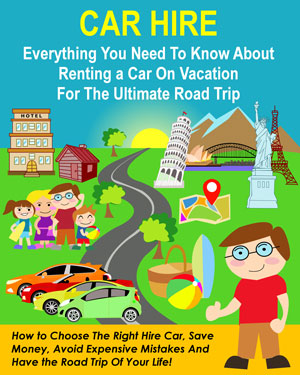
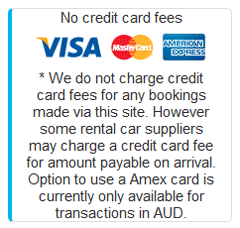
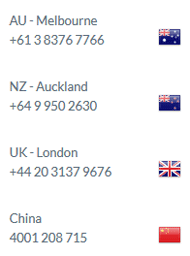
I really like it when people get together and share thoughts.
Great site, continue the good work!